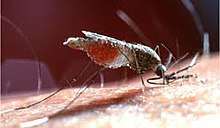Anopheles darlingi
Anopheles darlingi, the American malaria mosquito, is a species of mosquito in the family Culicidae.[1][2] A. darlingi is one of the major species of mosquito known to be responsible for malaria in the Amazonian regions.[3][4][5] It has a wide range of geographic distribution that stretches from Mexico and Argentina but it has also been found to populate in areas affected by deforestation and environment changes due to humans.[6]
| Anopheles darlingi | |
|---|---|
 | |
| Anopheles darlingi close up | |
| Scientific classification | |
| Kingdom: | Animalia |
| Phylum: | Arthropoda |
| Class: | Insecta |
| Order: | Diptera |
| Family: | Culicidae |
| Genus: | Anopheles |
| Species: | A. darlingi |
| Binomial name | |
| Anopheles darlingi Root, 1926 | |
Breeding
The breeding patterns of A. darlingi are affected heavily by the precipitation seen in their environment. Due to the fact that mosquitoes rely on the surfaces of stagnant water or areas with regular flooding as breeding grounds for their eggs and larvae,[5] the annual density of the A. darlingi population is dependent upon the availability of larval habitats.[3] During the wet season, riverine areas are often abundant with mosquitoes and densities are higher in these after the peak of rainfall.[7] Oppositely, in drier inland areas that are usually further from rivers and coexisting with the affects human disturbance, a peak of mosquito density may occasionally occur in the dry season in areas restricted to man-made dams and stagnant puddles.[7]
References
- "Anopheles darlingi Report". Integrated Taxonomic Information System. Retrieved 2020-01-22.
- "Anopheles darlingi". GBIF. Retrieved 2020-01-22.
- Hiwat, Hélène; Bretas, Gustavo (2011-09-16). "Ecology of Anopheles darlingi Root with respect to vector importance: a review". Parasites & Vectors. 4 (1). doi:10.1186/1756-3305-4-177. ISSN 1756-3305.
- World Health Organization. Global Malaria Programme. (2013). World malaria report 2013. World Health Organization. ISBN 978-92-4-156469-4. OCLC 880833659.
- Angêlla, Aline F; Salgueiro, Patrícia; Gil, Luiz HS; Vicente, José L; Pinto, João; Ribolla, Paulo EM (2014). "Seasonal genetic partitioning in the neotropical malaria vector, Anopheles darlingi". Malaria Journal. 13 (1): 203. doi:10.1186/1475-2875-13-203. ISSN 1475-2875.
- VITTOR, AMY YOMIKO; GILMAN, ROBERT H.; TIELSCH, JAMES; GLASS, GREGORY; SHIELDS, TIM; LOZANO, WAGNER SÁNCHEZ; PINEDO-CANCINO, VIVIANA; PATZ, JONATHAN A. (2006-01-01). "THE EFFECT OF DEFORESTATION ON THE HUMAN-BITING RATE OF ANOPHELES DARLINGI, THE PRIMARY VECTOR OF FALCIPARUM MALARIA IN THE PERUVIAN AMAZON". The American Journal of Tropical Medicine and Hygiene. 74 (1): 3–11. doi:10.4269/ajtmh.2006.74.3. ISSN 0002-9637.
- Gil, Luís H. Soares; Alves, Fabiana P.; Zieler, Helge; Salcedo, Juan M. V.; Durlacher, Rui R.; Cunha, Roberto P. A.; Tada, Mauro S.; Camargo, Luiz M. A.; Camargo, Erney P.; Pereira-Da-Silva, Luiz H. (2003-09-01). "Seasonal Malaria Transmission and Variation of Anopheline Density in Two Distinct Endemic Areas in Brazilian Amazônia". Journal of Medical Entomology. 40 (5): 636–641. doi:10.1603/0022-2585-40.5.636. ISSN 0022-2585.